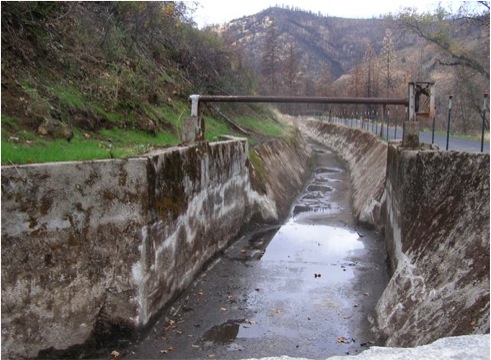In normal or wet water years, Hetch Hetchy Water and Power (HHWP) provides water from the Tuolumne River system to meet the needs of 2.6 million customers in the Bay Area. Normally that water is diverted at Hetch Hetchy Reservoir, while water captured in Lake Eleanor and Cherry Lake is used to generate hydroelectric power through Holm Power House. That Cherry Lake and Lake Eleanor water then flows on down the Tuolumne River to eventually fill Don Pedro Reservoir. Now HHWP proposes to divert much of that water in dry years instead of leaving it in the river. In 2014 HHWP proposed to reconstruct a long aqueduct (at right) and pipe system that was last used in 1988. Since the canal and pipes, as well as the Cherry Creek diversion site for the aqueduct, are located on national forest land, the project requires approval by the U.S. Forest Service. CSERC and other local groups have been generally accepting of San Francisco reconstructing the Lower Cherry Aqueduct in order to divert 48,000 acre-feet of water into HHWP’s “mountain tunnel” pipe system instead of letting the water flow on down the Tuolumne River. But we have urged that appropriate mitigation be done to reduce the environmental effects of so much water being lost to the River system.
Instead of identifying any middle ground mitigation measures that would allow the huge amount of water to be diverted while minimizing the impacts, HHWP instead took the position that diverting the water had no significant impact at all. Even though the amount of water to be diverted out of the River is double the total amount of water used by all Tuolumne County residents in a year, City consultants shrugged it off as insignificant. When CSERC attempted to get the City to clearly define with strict legal wording the exact times when the Lower Cherry Aqueduct would be allowed to divert all that water, HHWP consultants only provided wording that did not “tie their hands” by strictly limiting when diversions could occur. Rather than agreeing to only divert the water when State water officials declared a year to be an Extreme or Dry water year, City consultants declined to accept any tie at all to State water year assessments. While the final decision was not yet released, HHWP staff communicated the basics. As this newsletter goes to press, CSERC and other local environmental groups are considering whether or not to appeal and potentially litigate. It is reasonable for the City to divert precious available water in a true drought situation to meet the urgent, legitimate needs of Bay Area customers. But to make up for the Tuolumne River losing so much water, CSERC simply asks that HHWP mandate that the utility’s Bay Area customers reduce their use by 10% in years when the City diverts water from the river. The response we got from City representatives was that City officials prefer “flexibility” and don’t want to agree to require water conservation. County consultants also made the legally debatable claim that the Forest Service has no authority to consider the impacts of the water being diverted out of the Tuolumne River and can only consider the limited effects of the aqueduct and pipeline reconstruction. So, despite our Center and other groups spelling out very simple compromise solutions to speed the project forward, the City so far has rejected all requests for mitigation to make up for so much water being diverted out of the Tuolumne River.


